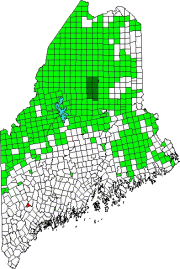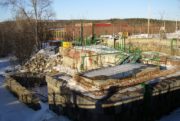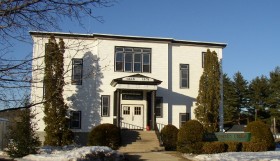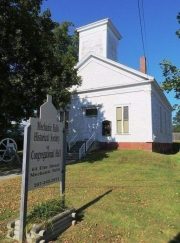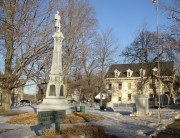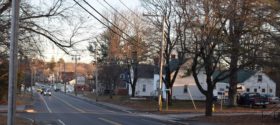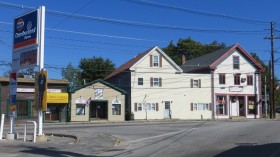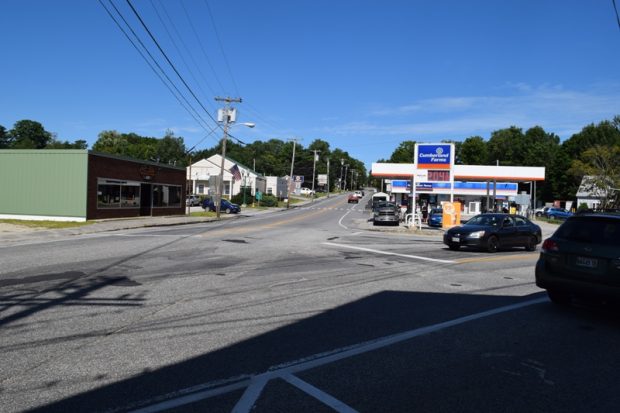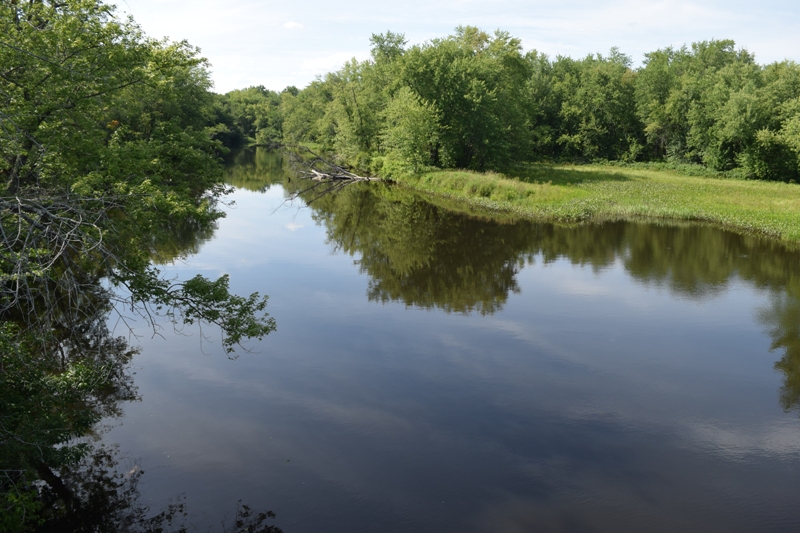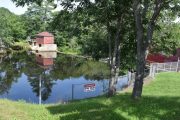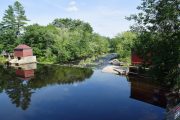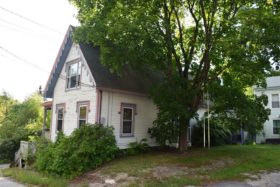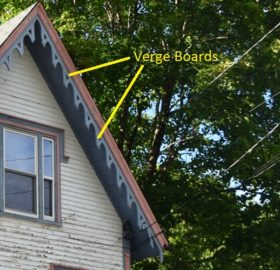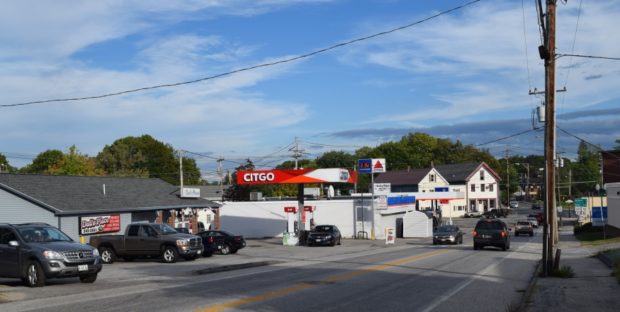
| Year | Population |
|---|---|
| 1970 | 2,193 |
| 1980 | 2,616 |
| 1990 | 2,919 |
| 2000 | 3,138 |
| 2010 | 3,031 |
| Geographic Data | |
|---|---|
| N. Latitude | 44:05:52 |
| W. Longitude | 70:24:25 |
| Maine House | District 72 |
| Maine Senate | District 20 |
| Congress | District 2 |
| Area sq. mi. | (total) 11.2 |
| Area sq. mi. | (land) 11.1 |
| Population/sq.mi. | (land) 273 |
| County: Androscoggin
Total=land+water; Land=land onl |
|
[muh-KAN-ihk falls] is a town in Androscoggin County, settled in 1769 and incorporated on March 22, 1893 from portions of Poland and Minot. The municipal office, right, is on Maine Route 11.
Ever since a paper mill was established on the Little Androscoggin River in 1850, the town has been part of Maine’s paper making economy. The river twists itself through the heart of the village, accompanied by the ghosts of vanished or aging structures that once were powered by its waters.
After several previous names (Jerico, Groggy Harbor, and Bog Falls), it was renamed in 1841 to recognize all the mechanics who serviced the factories in town.
One of the inventors of the Stanley Steamer automobile, Freeland O. Stanley, built some models here and was the town’s first high school principal.
The Evans brothers, Warren and George, born in nearby Norway, “put the small town of Mechanic Falls on the map as a center of firearms production.” Their Evans Rifle Manufacturing company, formally organized in 1873 with Joshua L. Chamberlain as President of the board of directors, made a popular repeating firearm in the 19th century.
The company “carried on the only mass production of firearms ever attempted in nineteenth century Maine,” according to Dwight Demeritt, Jr. A sample rifle was given to William F. “Buffalo Bill” Cody on May 12, 1877.
Once a thriving mill town, until its last one closed in 1981. The Marcal Paper Mill, the last of Mechanic Falls’ two paper mills, had employed about 250 people at the time that it closed as the only major employer in the town. The town struggled with the loss of its tax base and primary employer throughout the 1980s, but has experienced a dramatic renewal beginning in the 1990s.
East of Auburn at the junction of Maine Routes 11, 121 and 124, the town has seen modest population growth in recent decades.
Congressional Medal of Honor
Korean War
LEWIS L. MILLETT
Form of Government: Town Meeting-Council-Manager.
Additional resources
Demeritt, Dwight B., Jr. Maine Made Guns & Their Makers. Augusta: Friends of the Maine State Museum. 1997.
McCauley, Brian. The Names of Maine. How Maine Places Got Their Names and What They Mean. Wellesley, MA. Acadia Press. 2004. p. 106.
Waterman, Charles Elmer. Historical Sketch of the Town of Mechanic Falls. Mechanic Falls, Me. Ledger Pub. 1894.
A History Mechanic Falls, 1795-1893: In Commemoration of this Town’s 100th Year. Mechanic Falls, Me. Published by the Mechanic Falls Centennial Committee. 1993.
Mechanic Falls 2020
Another View of Downtown (below). A modest museum, The Maine Country Hall of Fame, occupies a small unit of a larger building off Lewiston Street.
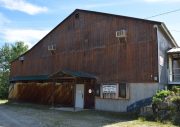
Maine Country Hall of Fame (2020)
The Little Androscoggin River
The Little Androscoggin River flows over 50 miles from Bryant Pond in Woodstock to its confluence with the Androscoggin River in Auburn. It also flows through the towns of Greenwood, West Paris, Paris/South Paris, Norway, Oxford, Minot, and Poland. The Little Androscoggin, in Mechanic Falls, flows through the “Hackett Mills” area of the Town and over a dam near several old buildings once dependent on its flow.
National Register of Historic Places – Listings
Elms
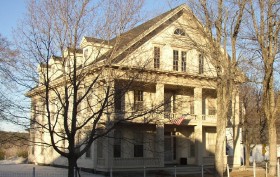 [Elm Street] “The Elms” built as a hotel, but for many years serving as a paper company office, is a reminder of a very prosperous period in Mechanic Falls when the water power from the Little Androscoggin River attracted manufacturing industries. The building is also important as an impressive and handsome statement in the late Greek Revival tradition which serves as an architectural focal point in the community. In 1859 A. C. Denison and Company built the Eagle Hotel; by at least one account it contained about forty rooms. The hotel, “one of the finest establishments of its kind east of Boston”, was operated by several landlords until about 1870 when Mr. A. C. Denison made it his residence.
[Elm Street] “The Elms” built as a hotel, but for many years serving as a paper company office, is a reminder of a very prosperous period in Mechanic Falls when the water power from the Little Androscoggin River attracted manufacturing industries. The building is also important as an impressive and handsome statement in the late Greek Revival tradition which serves as an architectural focal point in the community. In 1859 A. C. Denison and Company built the Eagle Hotel; by at least one account it contained about forty rooms. The hotel, “one of the finest establishments of its kind east of Boston”, was operated by several landlords until about 1870 when Mr. A. C. Denison made it his residence.
In 1887 a Mr. Jordan again opened the building as a hotel and changed its name to “The Elms”. Since then the building has apparently remained as an integral part of paper mill properties on the East side of the Little Androscoggin River. Although a map of the Town dated 1907 identifies the building as the Hotel Elms, the history of the structure since then is less certain. It has been the residence for the manager of the local paper mill.* [
Penney, Samuel, House
 [78 Maple Street] Built in in 1900, the Samuel R. Penney House is an extraordinary example of Colonial Revival Architecture. The 10 room house, excluding servants quarters, has extensive exterior and interior Neo-classical details. It was one of three identical houses, the only one to survive, commissioned by the brothers Samuel, Almont and Charles Penney to be near the family’s machine shop.
[78 Maple Street] Built in in 1900, the Samuel R. Penney House is an extraordinary example of Colonial Revival Architecture. The 10 room house, excluding servants quarters, has extensive exterior and interior Neo-classical details. It was one of three identical houses, the only one to survive, commissioned by the brothers Samuel, Almont and Charles Penney to be near the family’s machine shop.
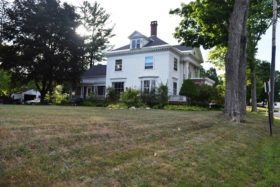 The J. W. Penney & Sons, Company was a well known and very successful family business specializing in steam engines and boilers. After training as a blacksmith and machinery repairman John Wintham Penney started a machine shop specializing in steam engines in 1880. The company manufactured steam engines, pulp and paper mill machinery, passenger and freight elevators, pulleys, hangers, shafting, and Finley paper cutters. They were dealers of boilers and steam driven appliances, and the company facilities included a machine shop, blacksmith shop, foundry, pattern shop, pattern house and warehouse, all located in the immediate vicinity of the family Maple Street residences. (2016 photos)
The J. W. Penney & Sons, Company was a well known and very successful family business specializing in steam engines and boilers. After training as a blacksmith and machinery repairman John Wintham Penney started a machine shop specializing in steam engines in 1880. The company manufactured steam engines, pulp and paper mill machinery, passenger and freight elevators, pulleys, hangers, shafting, and Finley paper cutters. They were dealers of boilers and steam driven appliances, and the company facilities included a machine shop, blacksmith shop, foundry, pattern shop, pattern house and warehouse, all located in the immediate vicinity of the family Maple Street residences. (2016 photos)
In 1898 Almont R. Penney met with the Stanley brothers, inventors of the Stanley Steamer. The company created the first production run of engines for the Steamer. The Stanley Steamer was one of the earliest steam automobiles and a very profitable and acclaimed invention of Maine natives F.E. and F.O. Stanley.
Seaverns, George, House
[8 High Street] The 1853 Gothic Revival George Seaverns house was built by, and the home of, a successful a local member of the paper making industry. Later in the 19th century it was the home of Charles E. Stevens, president of the Mechanic Falls Manufacturing Company, organized in 1883 to encourage shoe making locally. The building on the side of a hill once commanded a view of the community until later development intruded. Its application of the architectural feature “verge board” accentuates its Gothic style. (2016 photos)


